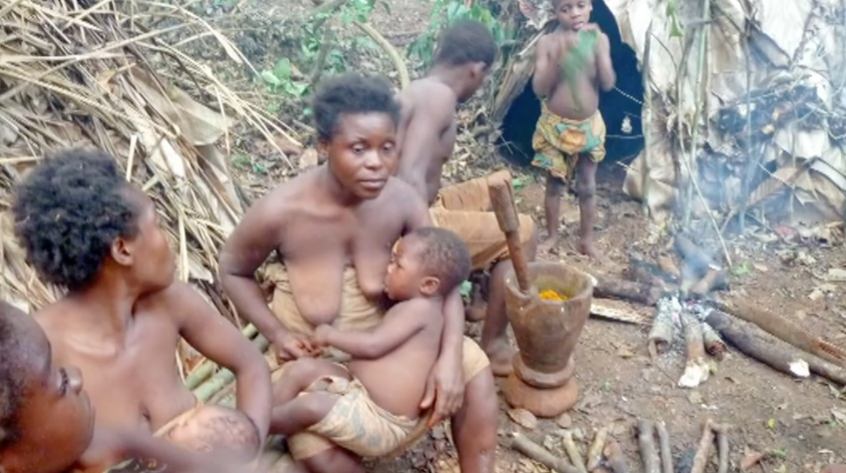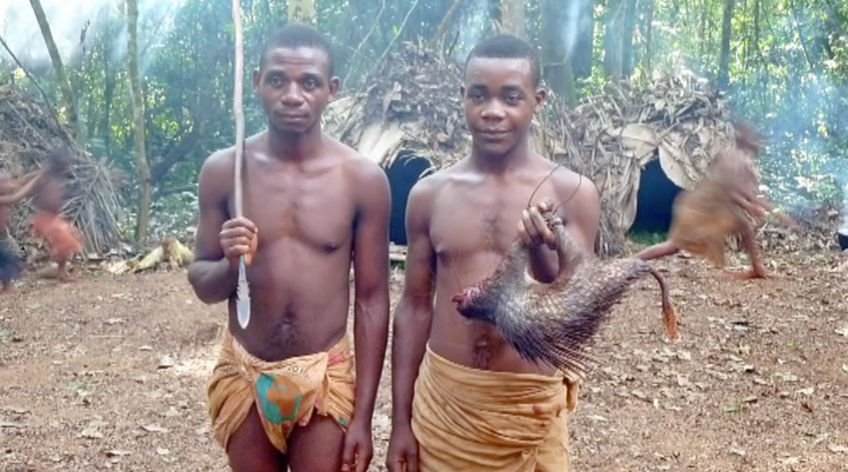T H E O R I G I N O F S O C I E T Y
T H E D I S C I P L I N E D O R D E R O F A N A R C H Y - A G I F T F R O M T H E W O M E N T O H U M A N I T Y
T H E L O N G J O U R N E Y F R O M H I E R A R C H Y T O E Q U A L I T Y
R E S E A R C H A B O U T TH E F O R E S T L I V I N G P E O P L E S S U P P O R T I N G
G I M B U T A S ´ T H E O R I E S A B O U T T H E C U L T U R E I N O L D E U R O P E

Today it seems to be quite a few anthropologists as well as evolutionary psychologist, paleoantologists, ethnomusicologists and others who are carrying out research about the forest-living Pygmy-peoples (an academically accepted term) in Central Africa and Southeast Asia, producing a body of findings that all of it seem to underpin the theorising of Maria Gimbutas about the peaceful egalitarian female / mother-centered culture, that characterised Old Europe, very well and thus at last once for all would have the potential to take the sting out of the attacks against it.
At the same time I notice that my own theorising about children´s play and making music reported of in my paper: very well fit in and goes along with these overall ideas.
Thus the different threads seem to converge in this one and the same lens: the anarchistic order of selforganisation
And this is what I will try to give a brief report of, in the following by referring to the research made by the evolutionary psychologist Phil D Peter Gray, who has carried out research about children´s play, reported of in his article:
as well as by Phil D Jerome Lewis having written a dissertation with the heading:
Abstract
"This thesis is about a forest hunter-gatherer people, the Mbendjele Yaka Pygmies of northern Congo-Brazzaville. The thesis is based on field research carried out between 1994 and 2001. I begin by examining certain key terms used in the thesis and by situating my research within the existing literature. Research methodologies are presented and the fieldwork experience described. I provide an overview of the historical, political and economic context of the research including an outline assessment of the main historical reconstructions of regional history. Conservationist and loggers' models of the forest are juxtaposed with Mbendjele ways of representing landscape and the forest environment. I discuss the significance of the forest in Mbendjele social experience and its role as the ideal environment for social life. I examine the way the Mbendjele classify animals and the cosmological significance of hunting and killing. This theme is continued with a presentation of ekila, a complex set of practices and beliefs that regulate the interactions of people with animals and express a complex relationship between human fertility and the correct handling of prey animals. I continue the analysis of Mbendjele collective representations with a presentation of the activity of massana. The link between children's play and adult rituals implicit in the use of this term is analysed. I then build on this understanding to present an analysis of aspects of two ritual associations, Ejengi and Ngoku, central to men's and women's power in society. The thesis is brought to a close by moving beyond the forest to examine Mbendjele relations with and conceptualisations of outsiders and property rights. New technological developments and financial incentives are increasingly transforming the Mbendjele forest into faunal and floral assets for distribution to international organizations."
Jerome Lewis is also bringing in the music ethnologist and ecologist aspects of "ngoma" of the play ( focused by myself in my writings in the discipline of musicpsychology ) as constituting the fundamental training of all the skills needed for to live a harmonic and psychological and physiological healthy life, but in this context specially designed for the life in the rainforest.
Here is a very interesting article about the Bayaka-people, written by Jerome Lewis: Egalitarian social organisation among hunter-gatherers: the case of the Mbendjele Bayaka - Jerome Lewis
And in this video he is lecturing at RAG ( The Radical Anthropology Group) about the great difference between this first kind of egalitarian hunter and gatherer culture built on whats called "short delay with the patriarchal kind of hierarcical culture that the pastoralists Hamar whose kind of labour division is built on the principle of uses delayed share,rendering the opportunity to manipulate, oppress and use both young men and women for the elder men´s use.
Egalitarian Gender Relations Jerome Lewis UCL RAG:
Woman’s Biggest Husband is the Moon: How Hunter-gatherers Maintain Social Equality 25 November 2014
THE ACCOUSTIC ARCH OF MUSIC CONNECTING CULTURE WITH NATURE

THE ORDER OF ANARCHY MIRRORING THE INHERIT GUYDING PRINCIPLES IN NATURE & COSMOS?
It's quite amazing how these Pygmy-people are living their lives, as smoothly and harmoniously as if they were flowers folding out their bliss and beauty from the core of their existence; the music, singing, dancing and the kind of ritual plays, they have been playing since times immemorial, all of it intervowen in a highly complex web of harmoniously fibonacci-related proportions. Almost like a miracle, without nobody telling anybody how, the eternal spiral of life continues to dissipate its blissful and highly intricate patterns over and over again. And that´s the way it has been since tens of thousands of years according to the latest findings in anthropological research, by tracing these peoples common myths and music, or maybe even as since as long ago as 70 000 years or more.
It must be considered the most optimal form of balancing Yin and Yang keeping a society running for such a long time. However this kind of system is not made up by nature, but quite the contrary by human creativity and intelligence and thus by culture, albeit a culture that develop skill in how to cooperate in the most optimal way with nature, i. e. constituting the "binary opposition" to the kind of patriarchial construct that´s striving for artificial products in order to legitimize its mother-defeat and arouse fear and respect.
From the very long way over the mammals and higher primates and further hominids of miljons and miljons of years of evolutionary transformations, there was all of a sudden a leap in the evolutionary history, a so called according to the systems theories, made up by some kind of revolution in the feedbackrelated loops in which the human brain was developed, ( to which I will return later; referring to Chris Nights extensive work: Blood Realations ), as it is a remarkable transformation that has taken place by the emergence of a hominid who is conscious, intellegent, creative and communicative enough to by him / herself create the cultural surroundings in which there are plenty of affordances to speed up the accumulatations of intelligence as well as other abilities even more; as for examplew the musical ones, in a neverending spiraling chain of life moving from lower to higher, even more complex systems of consciousness, intelligence and beauty.
This space is made by the arch of accoustics.

It may seem an unrealistic and / or farfetched idea that the social order of anarchy would unfold itself according to the same principles as the ones in the organic nature and cosmos , emerging as from itself and from the inside → out, as well as bottom → up, by people who have undergone intense training since childbirth to balance their own personal freedom and autonomy towards the group's demands for reciprocity and sharing / cooperation / gender equality, and could thus be delineated as anarchic - as either no leaders, nor governments, nor laws and imposed order is needed to keep society safe and running
Anyway that would have the potential of being a theory as simple as its is elegant to me.
Especially as its basically inculcated "DNA" or Mandelbrot fractal seems to be made up by musical "memes", thus at last but not least rendering some sense to Claude Lévi Strauss´ideas. And music is as much as flowers and other phenomena in nature made up by frequencies organised according to the fibonacci-serie as well. But the memes doesnt evolve by themselves but through conscious exercise from eaerly childhood on and / or even from before that, as foetuses in the wombs of the mothers, composing a special musical "meme" special to each and everyone of her children, thus making up an accoustic tie between mother and child already from its 24th week in the womb, from the listening capablities of the foetus is developed.
But that´s how far we can go in rendering credit to him, as his other ideas, from these last findings among the evolutionary reserach, as well as the research among the modern matriarchal studies, have turmed out to be the more errouneous. His most astonishingly naive and romantic model of the origin of society - the one of men exchanging women - a flagrant example of a patriarchal construct of delusion (defeating the mothers and the nature instead of cooperating together with them / it, ) being just too representative for the complete unrealistic idea about the Yin and Yang- parity of the Mandelbrot fractal-core made up by one part minus the another, instead of the two balancing each other.

This unrealistic idea of Lévi Strauss, made me ponder a lot of what kind of proportional relationship this dual parity in the Yin and Yang-core might be considered to consist, in the light of the new particle and quantum physics, as even in relation to fibonacci-serie or set: 1 / 1 or 1 / 2 or 2 / 3 and so on, or if it even would be possible to symbolise with the relationship of 1 / 0. And who knows, because according to this article about the findings by prof. Chien -Shiung Wu; THERE IS NO PARITY: CHIEN-SHIUNG WU it seems possible that it might be 2 / 3 or even 5 / 8 and so on. And in that case it would perhaps be the phenomenon which is initiating the spin from the very beginning, and is mimiced in the most basic and highly swinging african beat; namely two agains three.
And now we are getting even closer to the very core of the this exciting issue where all the lines converge; namely what to be defined and delineated as culture versus nature and what kind of culture is to prefer before the other and by whom and why. and the evolutionist aspects on all that. All of them hard questions to answer, as they are made up by qualitative aspects of science and not quantitative - which makes them very hard to deal with for the contemporary archaeologists who aren´t offered any systematical training for that purpose in their educational programs - a fundamental lack in the education that the German gender-archaeologist Brigitte Röder deeply regret in her famous work "Göttinnendämmerung", although not stopping her from disqualifying scholars who do have such a competence. And after having had a mail- conversation with some further professors in archaeology and anthropology about this flagrant shortcomings, it becomes even more evident that that´s the case not only in Germany, and the Anglo-Saxon countries but to a great extent even here in Sweden.
As a consequence of that, never before have science produced so many scholars telling us so very much about absolutely nothing, adopting the crowning touch of producing masses of texts which don´t tell anything at all that make sense, beyond the steadily recurrent unwarrent attacks on scholars whose intellectual and scholarly capacity lies far beyond their own, degrading them to "amateurs" and delineating their highly recognised contributions to science as "unscientific" or "popular-science" made by laypersons. (See Renfrew, Hodder, Conkey & Tringham, Monica Leppänen, Cynthia Eller, Brigitte Röder, Stefanie Knauss, )
The postprocessuralists are are making up a lot of quite harsh directives about the restrainment for the archaelogical methods making it more or less incompetent for makin any iunvestigstion of as kund about human cuktyres who are not documented in written records, i . e history, exluding religionos and mythological aspects genom att hänvisa till att ridskerna för projection är alltför stora folk beter sig på ett annat sätt än vad deras religion utsäger. Dvs de antas ha fungerat på samma sätt alltid som vi gör idag. RAG journal
Important questions.

BY KOPPLA UPP SIG TILL MUSIKEN THE PATTERNING OF YOUR BRAIN WILL BE
First, before I get to the three theories, I must address this question: Is it true that hunter-gatherers were peaceful egalitarians? The answer is yes.
Theory 1: Hunter-gatherers practiced a system of "reverse dominance" that prevented anyone from assuming power over others.
Theory 2: Hunter-gathers maintained equality by nurturing the playful side of their human nature, and play promotes equality.
Theory 3: Hunter-gatherers maintained their ethos of equality through their childrearing practices, which engendered feelings of trust and acceptance in each new generation.
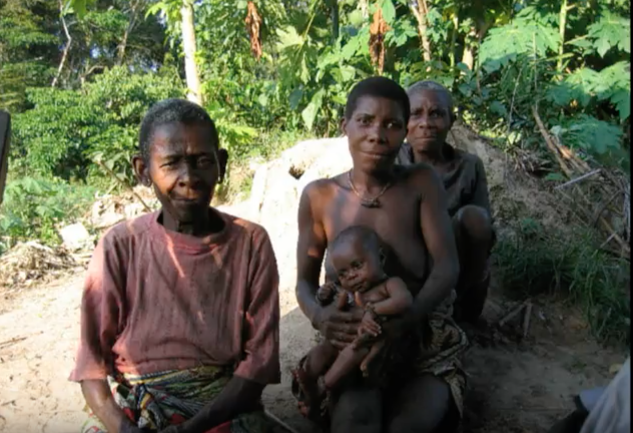
It's quite amazing with these Pygmy-people´s way of life. It flows as elegantly as when a flower develops its intricate fractal pattern - all by itself and has been doing for hundreds of thousands of years. They live completely without personal assets and accumulation of goods, but instead have developed an incredibly complex psychosocial / aesthetic basic structure, or rather "systems" because there is open change in variations of individual improvisations on top of it once for all the solid foundation. That is, always a balance between Yin o Yang, mostly maintained by non-verbal methods; through the dance / music / drama.
Great too that despite the tight organization everyone has their total freedom to come and go as they want without having to state ngn explanation for it or even say goodbye.
That's how the Origin of Society looks like. Now it is shown !!! Engels HADE right most of all but not everything; For example, inequalities do not automatically occur because of a division of labor between women and men, because it has always existed and still remains today in the matricar societies that still exist today today (Mosuo, Khasi, Minangkabu, Bijagos, Tuaregians, Akan People, Zapotec in Juchitan, Mexico, Kuna, etc.)
Another interesting encounter among all those who increasingly questioned the established science of archeology / antropology is the musician / South African Michael Tellinger, who thinks he is a hundreds of thousands of years old culture in South Africa on the tracks that also had a highly developed sophisticated culture as well as technology that used to use acoustic magnetic fields to train heavy objects and generate energy, has also been supported by the fact that his theories do not necessarily have to be so crazy anyway - since today you have found DNA from below that shows that there was gay sapiens varelsewr already 300,000 years ago
Everything is connected, and not least, the lack of balance in the smallest device yiing yang and the violence / ruling.
Creative people usually live on much smaller margins than others - h made themselves free from material needs. We have this in common with the forest people. They also devote their days to art / music / dance / drama. They call it themselves before "playing". Have never had more money to get involved with than social grants even give.
Elöin Wägner Women have top walk with subttle steps
TYST KUNSKAP GÅR DET INTE ATT VETENSKAPLIGGÖRA SÅDAN STIG WELINDER?

THE MUSICAL ARCH CONNECTING CULTURE WITH NATURE
HUMANITY REUNITE WITH HARMONY
Louis Sarno Dies at 62; Moved to Africa to Preserve Ancestral Music
“I was drawn to the heart of Africa by a song,” Mr. Sarno later recalled. “I boarded a plane that would take me into the equatorial heart of a continent where I did not know a soul, on a quest for a music that might have been nothing more than a state of my imagination.”
T H E O R I G I N O F S O C I E T I E S
On this page I am going to give a short overview of how the transition from the higher primates to the emergence of cultural societies among human beings might have been evolved according to the review of late evolutionary research, summarized by eminent preofessor Chris Knight in the forth Chapter of his extensive work; Blood Relations. Anfd her he once for all coming to terms with CLS model of The origin of Society (MOT)
There must have been some kind of ONSET for the radical change from TOP - DOWN hierarchies to BOTTOM -UP.
Some kind of mistake in the evolution to create animals who doesn´t treat each other well - jämför med växter blommor. Musik.
B O T T O M - U P L E A D E R L E S S A N A R C H I S T I C S Y S T E M S A M O N G T H E F I R S T H U M A N B E I N G S ?
T H E E M E R G E N C E O F S E L F G E N E R A T I N G, S E L F R E G U A L I T I N G & S E L F I M I T A T I N G P R I N C I P L E S
Tänk hur uppfinnsgsrikt och vackert allt ordnar in sig i vissa givna mönster och färger i naturen och dessutom i en variationsrikedom utan ände, utan att det står någon där och talar om för alla de enskilda aktörerna hur de ska göra- dom bara vet det ändå och det är precis hur konstigt som helst för oss människor att fatta.
Så här kan skinnet på en cameleont se ut, och det får mig att undra över hur det är med oss själva. Odnas också på samma sätt våra egna livsvävar in enligt vissa givna estetiska principer som bara vet själva hur de ska göra - eller ej? Jag tycker det här speglar den ultimat anarkistiska principen som grundläggande livsmönster i tillvaron och börjar bli riktigt konfundersam över hur det hela egentligen kan hänga ihop. Hur fasen kan alla delar från minsta kvark och uppåt veta hur de ska bete sig?
T H E L I F E O F T H E E G A L I T A R I A N H U N T E R A N D G A T H E R E R S
A society in which the parents hasn´t got the moral right to tell the children how to behave or what to do, but instead must refer to the will of the spirits and animals in the forest.
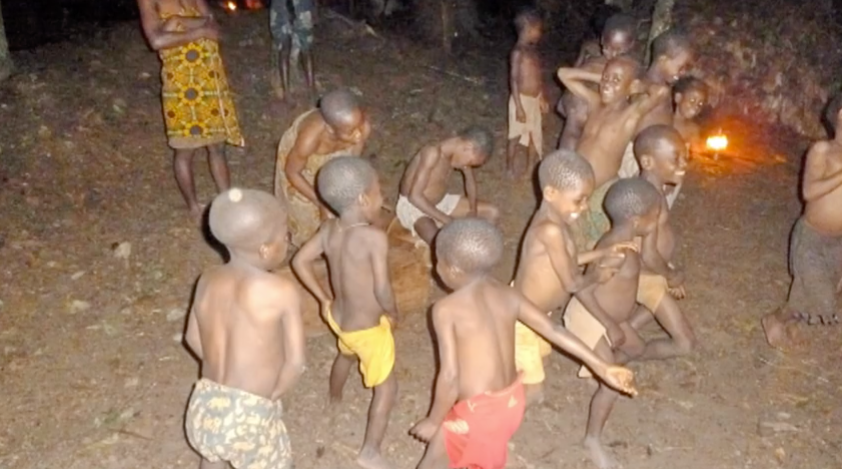
A society in which nobody wields authority over the other but the fundamental set of moral and behavioural values and manners are ingrained in everybodies nervsystem by the s called Ngoma o i.e. the totality of musical /dancing /dramatising / mimicing spiritual activities repeated on daily basis on different themes and in different constellations of young versus old, women vs men and / or everybody together, balancing the dependant fixed set of values a and rules against selfindependancy and creativity on a Yin and Yang basis that assures the survival of the society.
"It’s not coincidental that throughout history the most violently despotic and warlike societies have been those in which violence, or the threat of violence, is used to maintain domination of parent over child and man over woman."
Riane Eisler, The Power of Partnership: Seven Relationships that Will Change your Life
According to the systems theories developed in physichs and chemistry in the second half of the 20th century by nobel prize winner Ilya Prigogine et al, it has been argued that socio-cultural systems would follow the same inherit patterning and processing as has been discovered in the organic systems; almost like a mystery bearing forth totally new materia in a so called process of autopoiesis.
The term "autopoiesis" (from Greek αὐτo- (auto-), meaning 'self', and ποίησις (poiesis), meaning 'creation, production') refers to a system capable of reproducing and maintaining itself. The term was introduced in 1972 by Chilean biologists Humberto Maturana and Francisco Varela to define the self-maintaining chemistry of living cells. Since then the concept has been also applied to the fields of cognition, systems theory and sociology.)
Riane Eisler is the one who took up the challenge and developed her Cultural Transformation Theory CTT according to the ideas of the basic interrelated selfgenerating, selfsimilating, selfregulating and feedback-related processes in sociocultural life and especially so in regard to the powerbalance between men and women as the essential cell of "partnership" for what kind of culture / civilisation will be constructed thereupon: the partnership relation constituting that ideal original cell in society from which all the relationships will pick up its selfsimilitating patterns, as the opposition to the dominator system represented by the patriarchies, ruling the world the very last millenia.
Quoting the homepage of Riane Eisler:
While biological evolution of other animal species happens over millennia, cultural evolution for the human species can happen very quickly, states Riane Eisler in The Chalice and the Blade (1987). She writes that our human species’ biological evolution is unique. We have a highly evolved brain, allowing greater memory, information processing, flexibility, and versatility.
This means that we humans can change our behavior based on feedback. And the feedback coming at us today from all sides – environmentally, economically, socially – is that the mix of high technology and an ethos of domination and conquest are not sustainable."

ACTUALLY WE DON`T HAVE TO LEARN ANYTHING NEW BUT JUST TO TAKE CARE OF THE KNOWLEDGE HUMANITY HAS CULTIVATED SINCE TIMES IMMEMORIAL, BY IMITATING THE PATTERNS OF NATURE AND COSMOS - PREFERRABLY BY USING THE MEDIATOR IN BETWEEN THE ABSTRACT AND THE MATERIAL; NAMELY MUSIC / DANCE ie NGOMA.
FREEDOM VESUS SLAVERY
INDIVIDUALISM VERSUS COLLECTIVISM
Faulse dichotiomies
ENGELS; all other.
The more one gets aquainted with the type of social structure matriarchal societies represents; or better "system" as the word "structure" moreof reminds of closed fixated constructions as for example a car motor; which cannot re-create itself to the better or even reproduce itself) systems, but a type of organisation that´s open for change and flexible.
In social terms the open systems would in that case illustrates to me the relationship between really freedom and its opposite slavery.
This is illustrated by Jerome Lewis in his lecture by the fact that it needs a special kind of conscious construct of the fundamental pattern of the relationships in the pygmie-gropus, to facilitate true equality.
It doesnt´t unfold by itself at the starting point, as our predecessors among the primates certainly do not have evolved ab egalitarian system, but must, during the long path of becoming human, have been consciously constructed ( by whom?)
Sextrike or other strikes like the ones in Kenya - the beginnihgf of culture: Bakya creration story.
When its once is set it seems to have a strong potential to continue unfolding itself, reproducing its inherit fundamental pattern immensely in the same "anarchistic" way of construct organisations from BOTTOM - UP which more or less organise themselves by themselves without any kind of subordinate "leader" och authorative "chief" or outspoken rules and / or laws, resp. juridicial, police and militaty forces to keep the society intact.
This kind of patterning prossesses in open systems might perhaps be illustrated by the kind of eternally ongoing fractal patterning that has been exposed being prevailing in the organic nature, unfolding immense chains of repetative patterning from the inner core of a dual nucleus, but in an immense vary of constellations of new patterning formations, thus in the bottom preserving the same kind of firm core, constituting the safe framework needed in order to create something new. Anyhow I think that might be a mirroring of the way the selfgenerating and selfregulating emergence of flat egalitarian anarchistic societies function, thus just constituting another form av fractal pattering on the sociocultural psychological level..
As a mirror in a mirror everything is hold together and reaffirmed together with the music; who in itself very well is analogue to these kind of immerseley unfoldning fractal processes out of a simple core; building ever more complex patternings; many of them from the basic rythmic tension that´s emanating from two against three. i.e. one person claps her or his hand in a two-meter serie while another cclaps thremeter creating together a rythmic pattern
SHARING THE SAME CRERATION MYTH
In sharing the same creation myth Yaka people express their shared identity in terms of descent from the first forest people. Here, I will briefly describe the basic elements of the Yaka creation myth that are shared by the Mbendjele, Ngombe, Mikaya and Luma. In Chapter Seven I shall examine the Mbendjele version of the creation myth in more detail.
God (Komba, Njakε, or Bolo) makes a group of men and a group of women and puts them in different parts of the forest. The men copulated with mapombe (wild calabash-like fruit). The mapombe made lots of male children. The men hunted large game and collected honey. Elsewhere the women lived together and collected wild yams and fished. They danced Ejεngi and female children fell from the raffia of the forest spirit’s clothing. Ejεngi made them many children.
One day the kombeti (elder) of the men49 decided to go hunting alone. After a walk of several days he happened upon traces of the women. He heard the women singing and watched them from a hiding place. They saw him.
He returned and told the men about the women. The following day the men took many leaf parcels filled with honey and walked to the women’s camp. They stalked the women, encircled them [as in pig hunting], and then closed in. The women scattered in panic but wherever they went they were beaten with honey. The women tasted the honey and loved it. They decided to stay with the men. They gave the men Ejεngi, and the men abandoned the mapombe. Since then men have sex with women and women give birth to men’s children. Many generations passed and they lived together in the forest their numbers increasing greatly. However differences began to divide them and they broke up into groups.
The Ngombe are blamed for the break up into different groups. The Mbendjele, Mikaya and Luma say that the Ngombe started eating people and so the others left them. Contrary to Arens’ (1979) theory of cannibalism where it is a myth always claimed of others but never oneself, the Ngombe I talked to admitted to this (as do many Bilo groups in northern Congo50). First the Ngabo and Mbendjele broke away but stayed in the area. The Ngombe (the Baka) travelled west, dividing many years later once across the Sangha River in

"It would be absurd to try to return to the social relations of our hunter-gatherer ancestors. But these social relations did last for 100,000 years in the most successful anarchist-communism experiment in history. So there must be something to learn from hunter-gatherers. The pygmies of Central Africa traditionally live in ways that come closest to the ways prehistoric hunter-gathers may have lived, the anthropologist Jerome Lewis, argues in one of the most recent studies of the way African pygmies maintain egalitarian social relations and so make anarchist-communism work."
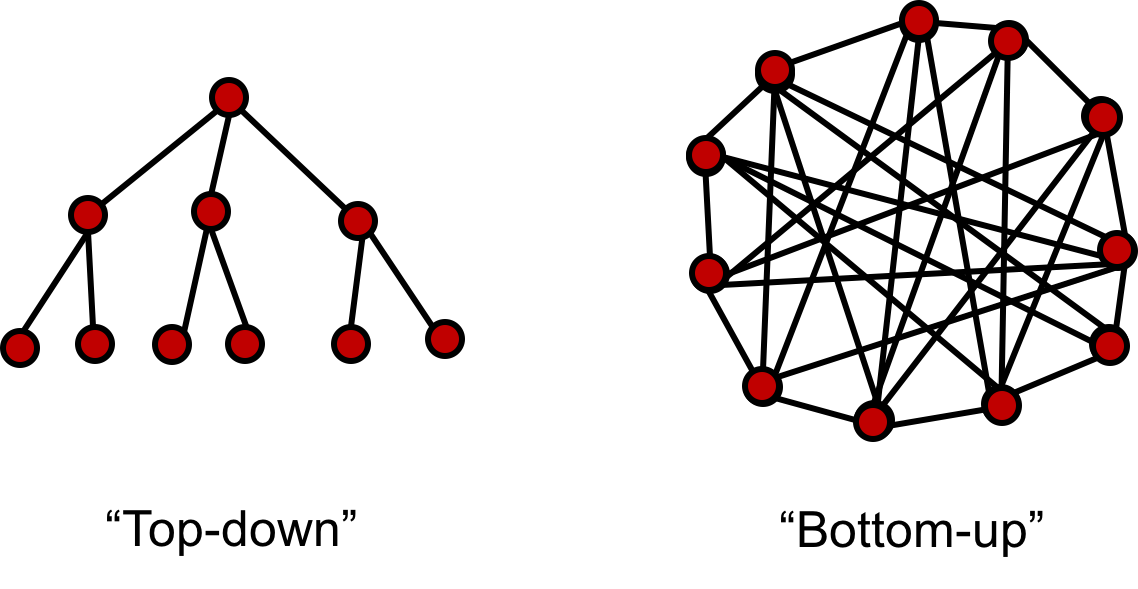
The Pygmies of Central Africa
The steady reduction in access to forest by Pygmy groups across central Africa has resulted in most being more accurately called “former hunter-gatherers” than hunter-gatherers. Today, the different Pygmy groups are characterized by great diversity (Bahuchet 2012). One small group in Cameroon, the Medzan, now occupies a savanna; many Twa groups in DR Congo, Burundi, Rwanda, and Uganda have sedentarized among farming communities; and increasing numbers of Baka in Cameroon and Gabon are becoming sedentarized and alcoholized, along roadsides (Agland 2012). All experience increasing pressure from rampant commercial hunting, artisanal and industrial mining and logging activities, protected areas encompassing good forest, and in some places warring militias, government forces, and refugees.
Despite the great diversity of situations that many Pygmy groups find themselves in today, they share some remarkable similarities. In particular, their egalitarian social organization is bound up in a matrix with other key cultural practices. Hewlett identified some of these as spending at least four months a year hunting and gathering in the forest; strongly identifying with and preferring forest life; contrasting the “forest world” to the “village world”; having economies based on demand-sharing; practicing important rituals associated with elephant hunting; having intimate parent-child relations; and diverse relationships with neighboring farming groups (1996).
Ethnomusicologists working among Pygmy groups across the Congo Basin remark on similarities in their unusual highly integrated choral yodeled (alternating between chest and head voice) and polyphonic (multiple overlapping melodies) singing style among groups living very far apart (Arom 1978, 1981, 1985 on western Pygmies; Cooke 1980; Demolin 1993 on the eastern Pygmies; Fürniss 1993, 1999, 2006, 2007; Fürniss and Bahuchet 1995 on western Pygmies; Kazadi 1981 on similarities across Tua or Twa groups in DRC; Merriman 1980 on similarities in DRC; Rouget 2004 on the Pygmy musical style; and others).
These well formulated words leads directly in to the core of the subject I would like to penetrate on this page.
The idea and phenomenon of anarchy gets namely inevitably highlighted the more you get entangled in the questions about the origin of society and aquainted with the the peoples still preserving the lifestyle from paleolithic times as for example the so called "Pygmé"-peoples like Mbendjele Bayaka and Orang Osil in Asia et al whereof some are presented by the brilliant anthropologist Jerome Lewis, as well as many other egalitarian and indepently selfsufficient matriarchal societies across the globe your thoughts automatically associate to the phenomenon of anarchy and there are goof reasons for that.
You can learn more about these highly interesting research about these egalitarian forest-living Pygmé peoples by Jerome Lewis and others, which has been carried out the last decades revealing a highly complex esthetical / musical / spiritual culture with an intricately elaborate inherit ambition and prowess how to sustain balance, peace and egalitarianism as well as personal freedom at one and the same time.
And that brings us to the next question about anarchy I found expressed in this quotation
"Anarchism, is the only philosophy which brings to man the conscious of himself which maintains that God, the State and society are non-existent, that their promises are null and void, since they can be fulfilled only through man´s subordination. Anarchism is therefore the teacher of the unity of life; not merely in nature."
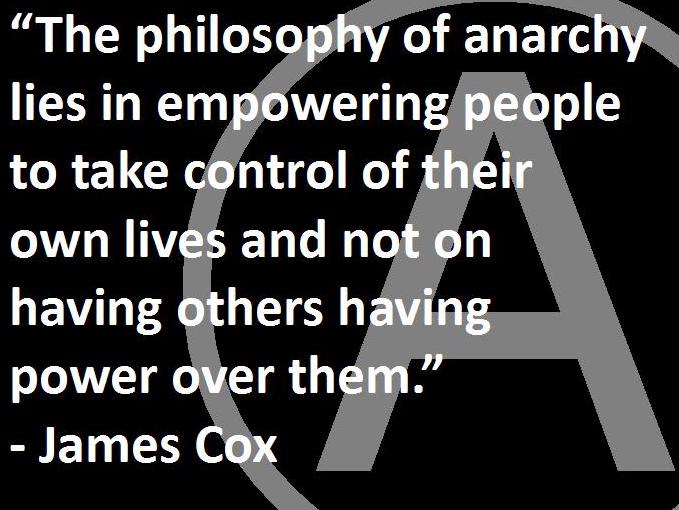
This touches namely an idea that was evoked in me since I had to grapple with the ideas of Claude Lévi Strauss and was struck by his own as well as his many followers and devoted admirers lack of critical questioning of the fundamental imbalance between male and female i.e yin and yan in his idea of the origin of society.
As there seem to be some many radical lefties among the academics who still cling to Lévi Strauss ideas, as well as feminists, as those represented by the archaeologists and anthropologists who dismisss Marija Gimbutas as a so called "essentialist", I have found this extreemely hard to accept and understand, firstly as it is totally irrational alogical, and secondly as it 180 degrees contradicts the fundamental marxist-leninist theory aboyút all later opprseeion origionating in the imbalance between man and woman.
Quoting: RAG
MAIL TILL KERSTIN
Samhällen som utvecklas enligt samma principer som råder i naturen styrs inifrån och ut och bottom - up av människor som sedan barnsben genomgått intensivträning att balansera sin egen personliga frihet gentemot gruppens krav på reciprocity and sharing / ett friktionsfritt samarbetet / jämställdhet är anarkistiska - behöver ingen statlig ledning - ingen ledening öht - det är det som är så fantastiskt med dessa bushmäns levnadsssätt. Det flyter på lika elegant som när en blomma utvecklar sitt invecklade fraktalmönster - alldeles av sig självt och har gjort så sedan hundratusentals år. De lever helt ochhållet utan personliga tillgångar och ackumulation av varor, men har istället utvecklat en otroligt komplex psykosocial / estetisk grundstruktur eller rättare sagt "system" eftersom det är öppetför förändring i fråga om variationer av individuella improvisationer ovanpå det en gång för alla fasta grundmönstret. Dvs hela tiden en balans mellan Yin o Yang som mestadels upprätthålls medelst ickeverbala metoder; genom dansen / musiken / dramat.
Fantastiskt också att trots den tighta organisaationen alla har sin totala frihet att komma och gå som de vill utan att behöva uppge ngn förklaring till det eller ens säga adjö.
Så ser alltså The Origin of Society ut. Nu är det visat!!! Engels HADE rätt i det mesta om än inte i allt; tex inträder inte ojämställdhet per automatik pgra en arbetsdelning mellan kvinnor och män för den har alltifd funnits och gör så fortfarande idag i de matriarkala samhällen som fortfande finns kvar idag världen över (Mosuo, Khasi; Minangkabu, Bijagos, Tuaregerna, Akan-folket, Zapotec i Juchitan i Mexico, Kuna mfl m fl)
En annan intressant uppstickarte bland alla dem som alltmer kommit att ifrågasätta den etablerade vetenskapen inom arkeologi / antroplogi är musikern / sydafrikanen Michael Tellinger som menar att han är en flera hundratusen år gammal kultur i Syd-afrika på spåren som också haft en högt utvecklad sofistikerad kultur och dessutom teknologi som använde sig av akustiska magnetfält för att elevera tunga föremål och alstra energi, har också fått stöd för att hans teorier inte alls behöver vara så tokiga ändå - då det ju ni i dagarna påfunnits DNA dänereifrån som visar att där fanns homo sapiens varelsewr redan för 300 000 år sedan
Allt hänger ihop och inte minst förhållandet brist på balans i minsta enheten yiing yang och våldet / härskandet .
Kreativa människor brukar kunna leva på mycket mindre marginaler än andra - h gjort sig fria från materiella behov. Det har vi gemensamt med skogsfolket. De ägnar också sina dagar åt konst / musik / dans /drama. De kallar det själva före att "leka". Har aldrig haft mer pengar att röra mig med än vad socialbidraget ger om ens det.
INLEDNING
__________________________________________________________________________
Den engelske antropologen Jerome Lewis (också han liksom Chis Knight medlen i RAG m fl har de senaste årtiondena bedrivit väldigt spännande forskning kring ett flertal regnskogsinvånare sk “Pygmy-people” I Centralafrika och Sydostasien, varmed har kunnat visa hur Homo sapiens-släktet tillbringat sin absolut längsta period här på jorden: nämligen som fredligt jämställda jägare - o samlare i sant anarkistiskt statslösa och fullkomligt antiauktoritära kulturer, som utgörs av mycket medvetet utarbetade strukturer, eller bättre “system”, eftersom “struktur” leder tanken till slutna rigida auktoritära system; men här är det fråga om öppna och flexibla sådana i balans med vissa grundläggande fasta principer.
Samtidigt med detta tycks det ha försiggått en hel del evolutionsforskning som på olika sätt kan bidra till att kasta ljus över denna övergång och / eller bekräfta de teorier som Lewis utarbetat utifrån sitt fältarbete.
Och därmed ställs vi inför många intressanta frågeställningar kring hur övergången från de tidigare primaternas starkt hierkiserade och mer eller mindre av alfahannar toppstyrda form av organisation, till den motsatt platta och egalitära som kommit att evolutioners fram tillsammans med Homo-sapienssläktet och som istället kommit till stånd genom mödrarnas ledning. Vilka specifika drag är det som i det avseendet kommit att skilja Homo sapiens åt från de tidigare hominiderna och vad är det som kan tänkas ha utgjort den evolutionära fördelen med en sådan platt egalitär organisation som deras till skillnad från de tidigare.
Prof. Chris Knight har en uttömmande redovisning av den forskning som företagits i detta avseende i fjärde kapitlet med rubriken The Sextrike, som han inleder med att ställa frågan hur mycket av evolutionsteoretisk significanse som kan anses som kan antas stötta Claude Livi Strauss ide om The Origin of Society, vilken han i slutet av sin genomgång menar sig kunna avfärda som ohållbar.
Och egentligen borde jag börja med att hänvisa till de viktigaste dragen i denna evolutionsteoretiska utredning men jag nöjer mig än så länge med att hänvisa läsarna att själva ta del av detta kapitel i Chris Knight, vari han redogör för sin teori om kvinnorna utnyttjande av sexstrejker under sina synkroniserade menstruationer i avsikten att skaffa sig ett övertag i förhållande till ett tidigare underläge.
För att göra en lång historia kort kanske man skulle kunna uttrycka det så, att Chris Knight i bjärt kontrast till CLS kommer fram till att The Origin of Society ligger just i dessa kvinnornas sexstrejker. Dvs det som Jerome Lewis framhåller i sitt föredrag om ?? I RAG:s föredragsserie; är precis det rakt motsatta; upphovet till den första mänskliga kulturen / civilisationen.
I vilket fall som helst är det enkelt att konstatera detsamma som Heide Göttner-Abendroth gör i sitt läromedel: Matriarc att CLS har tagit antropologins 150 år tillbaka till tiden före Bachofen. Ett perspektiv som får fullt stöd i professor som menar att antropologin numera tappat greppet, på det sätt som jag redan visat i min utläggning om den totalt fruktlösa forskning som bedrivs av och Larhammar utifrån idén att det skulle vara möjligt att kartlägga människan
Medlemmarna i RAG tycks dock ha ett bättre grepp än så då de tycks kombinera det ena med det andra och inte heller släppt tahet om det marxistiska perspektivet, för att inte tala om det brett upplagda tvärvetenskapliga perspektiv som anlagts i MMS, som tex inte minste det estetiska. HGA pekar på nödvändigheten att hänvisa till det oskiljaktiga förhållandet mellan estetik och den typ av “religionsutövning” eller hellre andlighet / förfädersdyrkan / kosmologi som utövats i den ursprungligt matriarkala shamanismen; det är framför allt genom musiken / dansen / dramat / som övergångarna från det ena medvetandestadiet till det andra sker och där de transformationer kan åstadkommas som är de avsedda, inte minst på så sätt att de lockar till sig sina förmödrars och förfäders andar att ta sin boning i de unga kvinnor som har till uppgift att återföda dem till sin klan.
Och här börjar det bränna till under fötterna rejält när nu Jerome Lewis m. fl av de nutida forskarna påvisat musiken / dansens / dramats stora, helt och hållet avgörande betydelse för de sk “Pygmy”-folkens platta ledarlösa, egalitärt anti-auktoritära och utpräglat anarkistiska organisationsform. Inte minst för min egen personliga del då ju detta är precis det område som utgjort föremålet för min egen påbörjade men aldrig avslutade forskningsansats i musikpsykologi. Och nu börjar jag känna igen mig precis; för här handlar det inte om mindre än precis ALLT det allra viktigaste i Homo sapiens liv; nämligen leken, kreativiteten, sammanhållningen, barnuppfostran, kontakt med andevärlden / känslolivet / träning av de kroppsliga rörelsefunktionerna / musklerna / finstämning av hjärnfunktionerna / finstämning av individernas uppträdande i förhållande till gruppens uppförandekoder, träning i att balansera den egna individuellt kreativa avvikelsen från den grundläggande strukturen och därmed självkänslan och det personliga initiativet … listan skulle kunna göras mycket längre; inte minst i förhållande till musikens integrerande funktion, i form av att liksom spänna som vida bågar över tid och rum som förbinder gruppens individer med varandra såväl som dess historiska föregångare, mödrar med sina barn som en extra navelsträng som grundläggs redan i moderlivet och varar livet ut under sina akustiskt skyddande valv.
ANALOGA GESTALTEN: Göra allt på en gång är mycket bättre än att göra en sak i taget.
Men då gäller det att ha klart för sig att det heller inte handlar om “musik” i den betydelse som vi lägger in i begreppet här i Väst, utan istället den form av integrerad mångmodalitet som inbegrips i det fenomen som i Sydafrika kallas för Ngoma och bland de Mbjendele Bayaka folk som Jerome Lewis beforskat för ??? och inbegriper alltså på en och samma gång både sång, dans, drama, rit, spex mm mm som ett slags totaluttryck för precis allt det som är viktigt här i livet kort sagt.
Och det enda som är viktigt i Bayakas liv liksom i övriga regnskogslevande folk tycks vara detta med musiken i skarp kontrast till vår västerländska livsstil i alla avseenden inte minst den i förhållande till värdering av materiella tillgångar som i deras fall är lika med noll.
Och nu är vi framme vid den mycket intressanta punkt som jag sett fram emot länge att närma mig i detta projekt av rewriting history: nämligen det högst fascinerade faktum att vi alltså med ganska stor säkerhet kan spola den gängse företrädda uppfattningen inom den etablerade västerländska vetenskapen som bli Pinker m fl. representerar nämligen att det skulle ha härskat kaos, våld och ond bråd död fram tom det stadium i den kulturella evolutionen då det bildats stater grundade på ett gemensamt försvar och rättsväsende och ordningsmakt och istället kan konstatera att det snarare är det motsatta som har gällt.; att människans längsta tid här påa jorden har utgjorts av samhällsorganisationer som i d¨så fall påminner mer om naturens egna processer av sk autopiiesis.
Så återigen kommer det faktum här till uttryck att patriarkala skapelserna utmärker sig genom att inta en konfrontation dikotomisk binär opposition till naturen såväl som till kvinnan och moderskapet, medan den tidigare matriarkala anarkistiska ordningen byggde på ett lyhört samarbete med naturens egna lagar.
För i naturen finns inga pyramidalt top-down styrda hierarkier utan enbart anarkistiskt bottom - up alstrande långa kedjor som repeterar sitt inneboden mönster i oändlighet på det sätt som kommer till uttryck i de fibonaki-relaterade fraktalmönsteren i den organiska naturen.
Och den kommunicerande förmedlingens emellan dessa olika “medvetandenivåer” är det alltså musiken som står för; det är dem som fungerar som den stora samordnaren av de mänskliga mönster med de övriga i naturen. Musikens mönster är jul även de inordnade i de fibonakitrelaterade balansakterna och borde alltså kunna antas skapa motsvarande balanserande harmoniska förhållanden i musikuövarnas psykofysiska utrustning. Musikpsykologi.
Men hur är det då med den vertikala hierarkiska ordning som tycks vara den rådande bland primaterna skulle den gå emot naturens egen ordning? Ja det är en svår fråga som jag inte lyckats hitta ngt svar på ännu. Bara att denna top-down styrda hierarki är långtifrån så entydig som det kan tyckas vid ett första ögonkast och dessutom
redan i detta skede vara på G att utveckla helt andra mer platta och female-dominerade
Under alla omständigheter tycks i varje fall en hel del evolutionsteoretiskt relaterade utvecklingsförlopp i gången från primat till Homo sapiens bedömas vara till stor fördel för spridningen av den senares gener till skillnad från den förstnämndas för satt ta ett klassiskt mått i bedömningen av dessa ting.
Ända sedan jag blev varse vilken högst konstlat onaturlig modell som Claude Lévi Strauss presenterade som The Origin of Society nämligen den om männens utbyte av kvinnor som handelsobjekt sig själva sinsemellan, som ju förutsätter att kvinnor skulle vara såna passiva viljelösa varelser att de frivilligt skulle underkasta sig en sådan behandling alternativt att den våldsutövning som, den förutsatte var helt OK, har jag funderat på hur man inom vetenskaperna har kunnat godta en sån totalt obalanserad grundfunktion i fråga om förhållandet mellan Yin och Yang som trovärdig och / eller föredömligt funktionsduglig i förhållande till konstruktionen av fredligt civiliserade samhällsorganisationer och letat efter svar på frågan om vad som utgörs av den duala kärnan i de vortexrelaterade energiflödena i naturen som vecklar ut sina fraktala evighetsspiraler - skulle den kunna fungera om den ena hälften av denna kärna bestod av i och den andra av noll på ett sätt som skulle motsvara den patriarkala ide´m om manlig och kvinnlig underordning med an aktiv part och en fullständig passiv.
Och hitintills har jag inte lyckats hitta ngt svar på den frågan mer än i så fall möjligtvis i förhållande till det som avhandlas i den här artikeln om i fråga om sk “pioner” i pariteter. Jag vet inte alls om jag har fattat ngt rätt i detta avseende men vad jag kan utläsa av detta tycks det alltså inte alls förhålla sig så, som de manliga nobelpristagarna felaktigt hade antagit att båda delarna i pariteten består av samma antal materia eller energier (eller vad det nu är fråga om?) utan den ena två och den andra tre, vilket kanske är nödvändigt för att det ska uppstå en spänning som leder över i dynamik.
Etta nolla däremot, i betydelsen materia kontra ickemateria, eller energi kontra ickeenergi skulle ju i motsats därtill enbart leda till kollaps - ett dynamiskt förhållande som också kommer till uttryck i samma video.
Och som ytterligare ett exempel på en mer balanserande manlig / kvinnlig Yin / Yan-princip i den här videon framställs geometriska formerna kuben och sfären som manlig resp. kvinnliga i sin förmåga att omsluta alla övriga geometriska former inom sitt “skal”
Ja dessa resonemang verkar kanske långsökta i sammanhanget; men har iaf inte släppt greppet om mig sen jag blev uppmärksam Lévi Strauss egna spekulationer kring myternas funktion som ett slags inbyggd funktion i det allmänna undermedvetna vars uppgift är att utgöra ett slags smörjmedel för det kognitiva maskineriet genom att inordna perceptionerna i binära oppositioner. För mig är det totalt ofattbart hur ett så löst grundat tankebygge, har kunnat sätta så stort avtryck på den moderna antropologin som är har varit fallet.
Å andra sidan landar faktiskt dessa teorier ganska nära den verklighet som vist sig vara sann i fråga om musikens roll i “Pygmy”-folkens organiserande principer fast då i helt motsatt syfte till inordnande i binära oppositioner mellan natur och kultur. Någon slags inordnande principer tycks det lugga i kosmos /naturen som även vi människor drabbas av eller mer eller mindre medvetet kan koppla upp oss gentemot eller inte. kommiunikationssystem som omtalas i den nya fysiken / kemin som ett slags “medvetande”.
I detta framträder återigen med all önskvärd tydlighet den oerhört bristfälliga enögdhet som olyckligtvis att prägla den västerländska vetenskapen sedan dess tillkomst under upplysningstiden; nämligen tendensen att tänka i ANTINGEN - ELLER istället för BÅDE-OCH - AVSKILJANDETS princip och den har inbyggt hierarkiserande implikationer.
Sedd ur de nya systemteoretiskt grundade rön som kommit att prägla den paradigmatiskt nyorienterande vetenskapen efter WWII och det postkoloniala paradigmskiftet, och som Riane Eisler haft till grund för utvecklandet av TTC har däremot en sådan BÅDE _ OCH -relaterad hållning kommit att framträda iom hennes återkoppling till den balanserade partnerskapsrelation som varit den rådande i mänsklighetens längsta tillvaro här opp jorden fram till den olyckliga tid som drivit sig själv mot sin egen undergång pyra bristen på inneboende balans i det hon kallar för ett “dominator” eller härskarsystem.
Vilket inte minst tycks vara vad denna studie har kommit fram till om jag förstått saken rätt, vilket jag dock inte alls är säker på.
de evolutionära processer som frambringar dessa ursprungligt anarkistiska samhällsorganisationer ser ut att utgöra en spegling av just de självalstrande självgenererande och självreglerande processer som kartlagts av P och som sedan Eisler tagit fasta på
